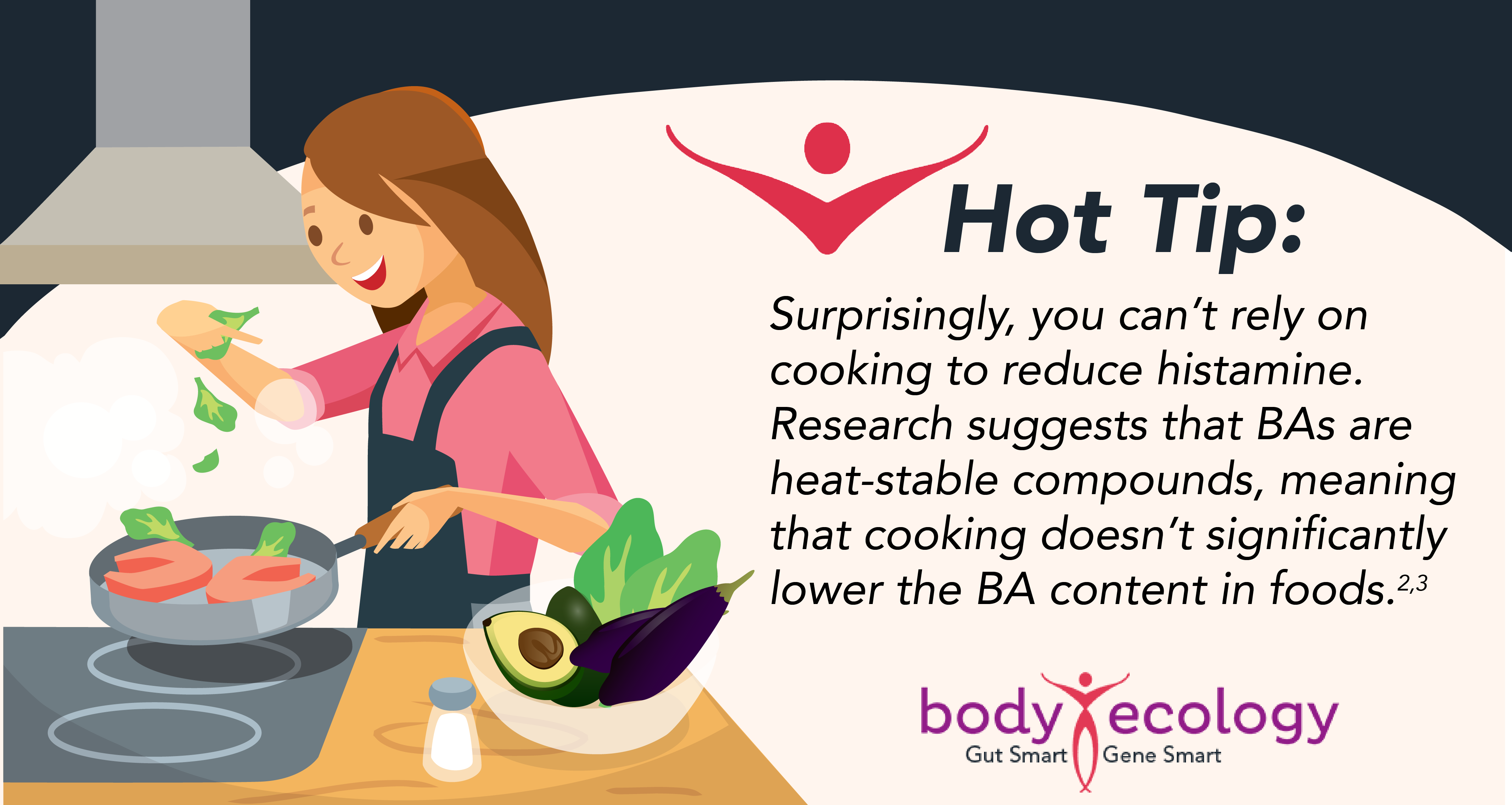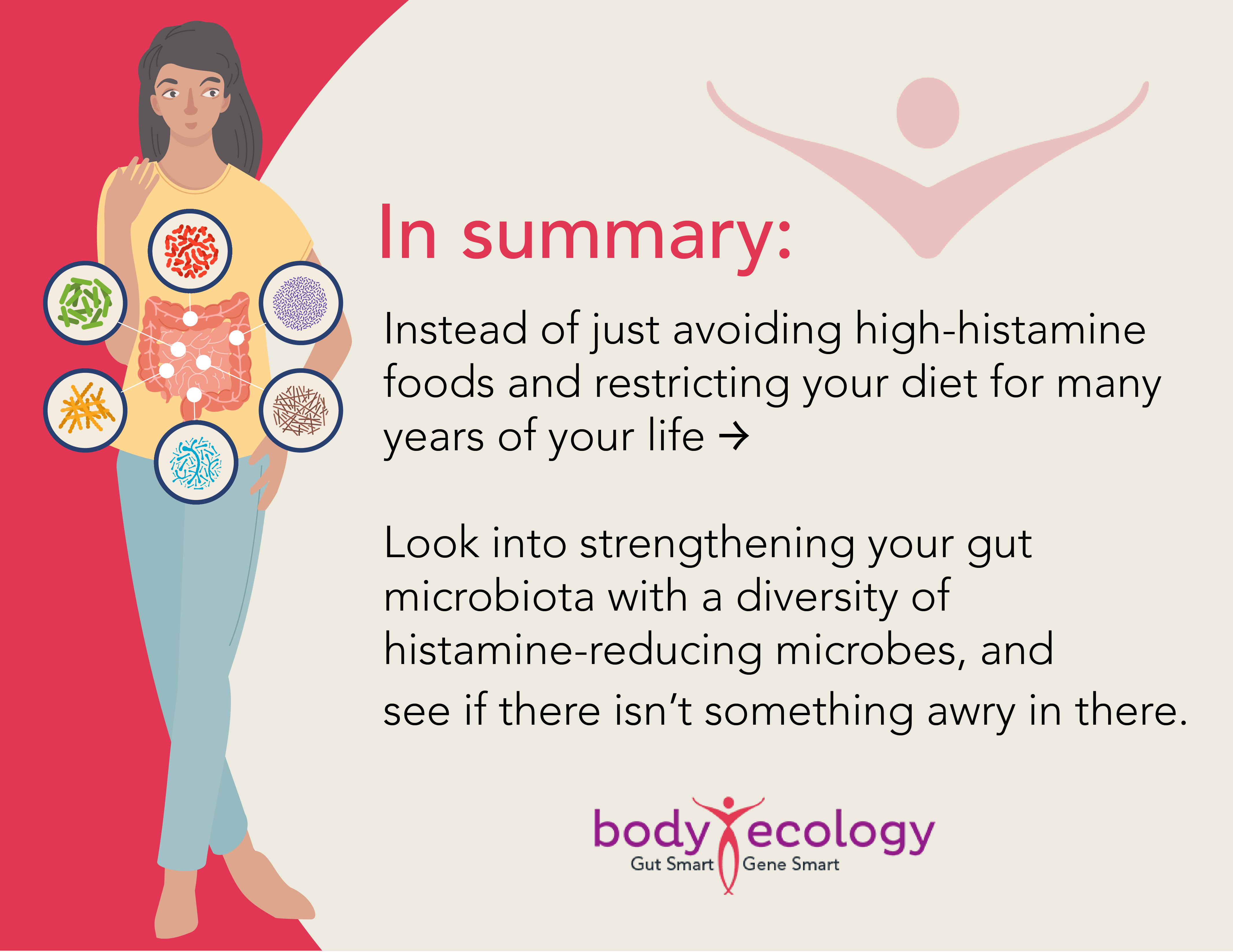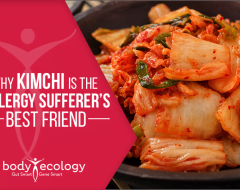
Part 2: Do this if you’re sensitive to histamine
There are several ways to reduce histamine intake and the overall level of biogenic amines (BAs) in food and in your body. One of the most important? Making sure to use high-quality foods to begin with that are fresh or fresh-frozen and inspect food carefully.

You’ll want to avoid animal proteins and moldy fruits, vegetables, and grains. (Grains often have mold.) Bacteria and fungus (mold) growing quickly on these foods will cause a histamine reaction.
To learn more, catch up on part 1 of this article.
The reason why it’s an absolute ‘must’ to store foods properly
Along with focusing on food quality, it’s also important to consider how you store your foods. Take care not to let fish, meats, seafood, cheeses, and other high-biogenic-amine foods sit out for long periods.
Fish are especially likely to develop bacteria immediately. Instead, store them at a controlled temperature in the refrigerator or freezer.
Storing foods in vacuum packs at a cool 38 degrees Fahrenheit (4 degrees Celsius or below) can also reduce BA levels.1

Certain food additives can inhibit BA formation:
- These include the common and safe food additives D-sorbitol, succinic acid, malic acid, and ascorbic acid (vitamin C), which lessen the activity of the enzyme decarboxylase to reduce histamine production.4 Citric acid is easily purchased online and in many grocery stores.
- Adding 1 percent of citric acid to cabbage during fermentation can lower the level of biogenic amines in the resulting pickle, while potassium sorbate and ascorbic acid (vitamin C) significantly reduce BA formation in sausages.5,6
- Mixing a 5-percent garlic extract into fermented anchovies was shown to reduce BAs by around 8.7 percent in one study.7
Salt, too, appears to decrease the formation of BAs in sausages, miso, and cheese.8-10 It’s still a good idea to watch salt intake — or more accurately, watch the quality of salt intake. When salt is blamed for potentially raising blood pressure and creating a risk of cardiovascular disease, it’s the refined salt that is so prevalent in the Western diet.
If you eat out in restaurants and purchase processed food, you’re only eating this dangerous salt. And in some cases, the addition of salt actually heightens BA formation. This was seen with histamine levels reaching toxic amounts in Spanish mackerel when using a concentration of 13 to 15-percent salt.11
Other ways to reduce BAs include food preservation methods like:
- Hydrostatic pressure (high-pressure preservation without using heat/additives)
- Irradiation
- Pasteurization
- Smoking
One other option for inhibiting BA accumulation in food is to use an amine-negative starter culture for fermentation and culturing. Read on to see what this means.
An inflamed and wounded gut might not be able to produce enough histamine-reducing enzymes to take on the histamine load in your digestive tract. Sign up for the Healthy Gut Summit now.
Will fermenting help to reduce histamine and BA formation?
While fermentation can be a source of histamine and other biogenic amines, there’s also evidence that some starter cultures actually inhibit the formation of BAs. This has been seen in the production of sausage, wine, fish sauce, and cheese, for instance.12-16
Certain strains of bacteria help prevent the growth of microbes that produce BAs, while being incapable of producing BAs themselves. The result being a decrease, if not total elimination, of BAs like histamine in the end product.
Which strains are we talking about? Here are a few that appear to stop BA formation during fermentation:
- L. sakei K29 reduced tyramine, cadaverine, and putrescine in chorizo dry sausages.17
- L. sakei, P. pentosaceous, S. carnosus, and S. xylosus used in combination in Turkish soudjoucks decreased putrescine.18
- L. farciminis and S. saprophyticus in Xinese fermented sausage helped lower tyramine, histamine, cadaverine, and putrescine.19
L. sakei is a common microbe found in kimchi and our Body Ecology cultured recipes.
Use of these strains isn’t foolproof, however. Indeed, one study found that sausages inoculated with P. pentosaceus and S. xylosus had the highest concentration of BAs.20
What about other, perhaps better-known, probiotic strains? It seems that one of our favorite strains here at Body Ecology, Lactobacillus plantarum, may be just the ticket to reducing histamine and other BAs.
L. plantarum produces DAO enzymes that help break down histamine in, for example, cultured veggies and sauerkraut.
Lactobacillus casei subsp. casei 2763 and Lactobacillus curvatus 2771 were also effective at reducing BAs in sauerkraut.21 Researchers have demonstrated the benefits of L. plantarum in a starter culture to decrease levels of BAs in sausages and cheese too.22,23
In another study, researchers found no tyramine present after using the following probiotic bacteria when making douchi (fermented black bean or soybean):
1. Lactobacillus rhamnosus GG (LGG)
2. Lactobacillus casei Shirota (LcS)
3. Escherichia coli Nissle 1917 (EcN)
Black beans were fermented using the three strains anaerobically at 37 or 20 degrees Celsius, with the starter culture strains, temperature, and presence of oxygen critical to controlling the production of harmful BAs.24
Some industrious researchers have even figured out how to inoculate wine with a robust starter culture to prevent the production of biogenic amines.25 L. plantarum has also shown success at keeping BA levels low in wine.26
Busting the myth that you have to avoid fermented foods to limit histamine
To start, it’s important that we correct the current myth circulating all over the internet (and stated in podcasts and in the many books on gut dysbiosis) to avoid fermented foods. They’re not all the same.
The experts who make this claim have a very limited understanding of fermented foods and especially the use of starters. They have not done their research. You can’t lump all fermented foods into one bucket. There’s a big difference between kombucha and Body Ecology’s fermented vegetables.
Basically, even if you react to histamine in food, you should still be able to eat cultured veggies made using the Body Ecology Starter Culture with L. plantarum.
What’s more, you can also use that starter to ferment coconut water and to culture butter that will be low in BAs, such as histamine. Once Donna Gates dug into the proof of what she suspected the whole time, it’s been a struggle getting the right information out to the practitioners and the public. So, please help us bust this myth when you can. Perhaps one day, fermented foods will be required to be labeled as high in histamine.
However, if you’re one of those people reacting to histamine in foods, look to the health of your gut. You may have candida, mold, or other bacteria making you histamine-sensitive, and these pathogens need to be eliminated.
To help achieve this, follow this step-by-step course of action:
1. Step one: Remove pathogens first.
2. Step two: Repair the gut lining, which repairs quickly once you remove the source of the infection and inflammation. Initially, do avoid most fermented foods while you focus on healing your gut.
3. Step three: Repopulate your inner ecosystem with key strains of beneficial microbes. Body Ecology’s popular Bifidus Power Blend will be back in stock in October, and our newest Histamine Reducing Probiotic will be available then also. Diversity is essential for a hardy ecosystem, and the hardiest microbes can be found in cultured veggie recipes made the Body Ecology Way.
Our new GI Distress Relief, with the beneficial yeast S. boulardii, has two strains of Bifidus bacteria that have been shown to help with Irritable Bowel problems (IBS). Likewise, EcoPhage is excellent for targeting E.coli overgrowth, often the cause of SIBO.
Your goal at first will be to avoid most fermented and other popular high-histamine foods and drinks — but hopefully, not forever.
As for those BAs in beloved foods that do have histamine — chocolate, nuts and seeds, avocado, tofu, tomatoes, spinach, wheat-free tamari, bacon, deli meat, beer, and wine — if you start by creating a healthy inner ecosystem while initially minimizing or avoiding them in your diet, these foods should one day no longer trigger a high-histamine reaction.

While you get a handle on your gut health, consider using a histamine-reducing digestive enzyme with DAO like Histame or Histamine Block to help break down those BAs as an added layer of protection.
†Note that these figures may vary slightly from batch to batch.
REFERENCES:
- 1. Fatih Özogul, Yesim Özogul, Biogenic amine content and biogenic amine quality indices of sardines (Sardina pilchardus) stored in modified atmosphere packaging and vacuum packaging, Food Chemistry, Volume 99, Issue 3, 2006, Pages 574-578, ISSN 0308-8146, https://doi.org/10.1016/j.foodchem.2005.08.029.
- 2. Wanaporn Tapingkae, Somboon Tanasupawat, Kirk L. Parkin, Soottawat Benjakul, Wonnop Visessanguan, Degradation of histamine by extremely halophilic archaea isolated from high salt-fermented fishery products, Enzyme and Microbial Technology, Volume 46, Issue 2, 2010, Pages 92-99, ISSN 0141-0229, https://doi.org/10.1016/j.enzmictec.2009.10.011.
- 3. Shalaby AR. Changes in biogenic amines in mature and germinating legume seeds and their behavior during cooking. Nahrung. 2000 Feb;44(1):23-7. doi: 10.1002/(SICI)1521-3803(20000101)44:1<23::AID-FOOD23>3.0.CO;2-B. PMID: 10702995.
- 4. Ali R. Shalaby, Significance of biogenic amines to food safety and human health, Food Research International, Volume 29, Issue 7, 1996, Pages 675-690, ISSN 0963-9969, https://doi.org/10.1016/S0963-9969(96)00066-X.
- 5. Bozkurt H, Erkmen O. Effects of Temperature, Humidity and Additives on the Formation of Biogenic Amines in Sucuk during Ripening and Storage Periods. Food Science and Technology International. 2004;10(1):21-28. doi:10.1177/1082013204041992.
- 6. Yucel, Ufuk & Üren, A. (2008). Biogenic amines in Turkish type pickled cabbage: Effects of salt and citric acid concentration. Acta Alimentaria – ACTA ALIMENT. 37. 115-122. 10.1556/AAlim.2007.0022.
- 7. Jae-Hyung Mah, Young Jun Kim, Han-Joon Hwang, Inhibitory effects of garlic and other spices on biogenic amine production in Myeolchi-jeot, Korean salted and fermented anchovy product, Food Control, Volume 20, Issue 5, 2009, Pages 449-454, ISSN 0956-7135, https://doi.org/10.1016/j.foodcont.2008.07.006.
- 8. Roseiro C, Santos C, Sol M, Silva L, Fernandes I. Prevalence of biogenic amines during ripening of a traditional dry fermented pork sausage and its relation to the amount of sodium chloride added. Meat Sci. 2006 Nov;74(3):557-63. doi: 10.1016/j.meatsci.2006.03.030. Epub 2006 May 19. PMID: 22063060.
- 9. Chin KH, Koehler PE. Effect of Salt Concentration and Incubation Temperature on Formation of Histamine, Phenethylamine, Tryptamine and Tyramine During Miso Fermentation. J Food Prot. 1986 Jun;49(6):423-427. doi: 10.4315/0362-028X-49.6.423. PMID: 30959661.
- 10. Gardin F, Martuscelli M, Caruso MC, Galgano F, Crudele MA, Favati F, Guerzoni ME, Suzzi G. Effects of pH, temperature and NaCl concentration on the growth kinetics, proteolytic activity and biogenic amine production of Enterococcus faecalis. Int J Food Microbiol. 2001 Feb 28;64(1-2):105-17. doi: 10.1016/s0168-1605(00)00445-1. PMID: 11252492.
- 11. Orawan Kongpun & Pantip Suwansakornkul (2000) Histamine Formation During Salting of Spanish Mackerel (Scomberomorus commerson), Journal of Aquatic Food Product Technology, 9:1, 21-30, DOI: 10.1300/J030v09n01_03.
- 12. La Gioia F, Rizzotti L, Rossi F, Gardini F, Tabanelli G, Torriani S. Identification of a tyrosine decarboxylase gene (tdcA) in Streptococcus thermophilus 1TT45 and analysis of its expression and tyramine production in milk. Appl Environ Microbiol. 2011;77(3):1140-1144. doi:10.1128/AEM.01928-10.
- 13. Gardini F, Martuscelli M, Crudele MA, Paparella A, Suzzi G. Use of Staphylococcus xylosus as a starter culture in dried sausages: effect on the biogenic amine content. Meat Sci. 2002 Jul;61(3):275-83. doi: 10.1016/s0309-1740(01)00193-0. PMID: 22060850.
- 14. García-Ruiz A, González-Rompinelli EM, Bartolomé B, Moreno-Arribas MV. Potential of wine-associated lactic acid bacteria to degrade biogenic amines. Int J Food Microbiol. 2011 Aug 2;148(2):115-20. doi: 10.1016/j.ijfoodmicro.2011.05.009. Epub 2011 May 18. PMID: 21641669.
- 15. Zaman MZ, Abu Bakar F, Jinap S, Bakar J. Novel starter cultures to inhibit biogenic amines accumulation during fish sauce fermentation. Int J Food Microbiol. 2011 Jan 31;145(1):84-91. doi: 10.1016/j.ijfoodmicro.2010.11.031. Epub 2010 Nov 26. PMID: 21183239.
- 16. P. Nieto-Arribas, J.M. Poveda, S. Seseña, Ll. Palop, L. Cabezas, Technological characterization of Lactobacillus isolates from traditional Manchego cheese for potential use as adjunct starter cultures, Food Control, Volume 20, Issue 12, 2009, Pages 1092-1098, ISSN 0956-7135, https://doi.org/10.1016/j.foodcont.2009.03.001.
- 17. Consuelo González-Fernández, E.M. Santos, Isabel Jaime, Jordi Rovira, Influence of starter cultures and sugar concentrations on biogenic amine contents in chorizo dry sausage, Food Microbiology, Volume 20, Issue 3, 2003, Pages 275-284, ISSN 0740-0020, https://doi.org/10.1016/S0740-0020(02)00157-0.
- 18. Ayhan K, Kolsarici N, Ozkan GA. The effects of a starter culture on the formation of biogenic amines in Turkish soudjoucks. Meat Sci. 1999 Nov;53(3):183-8. doi: 10.1016/s0309-1740(99)00046-7. PMID: 22063199.
- 19. Shiling Lu, Xinglian Xu, Guanghong Zhou, Zhiyuan Zhu, Yong Meng, Yuanming Sun, Effect of starter cultures on microbial ecosystem and biogenic amines in fermented sausage, Food Control, Volume 21, Issue 4, 2010, Pages 444-449, ISSN 0956-7135, https://doi.org/10.1016/j.foodcont.2009.07.008.
- 20. Rubén Domínguez, Paulo E. Munekata, Rubén Agregán, José M. Lorenzo, Effect of commercial starter cultures on free amino acid, biogenic amine and free fatty acid contents in dry-cured foal sausage, LWT – Food Science and Technology, Volume 71, 2016, Pages 47-53, ISSN 0023-6438, https://doi.org/10.1016/j.lwt.2016.03.016.
- 21. Mohamed A. Rabie, Hassan Siliha, Soher el-Saidy, Ahmed A. el-Badawy, F. Xavier Malcata, Reduced biogenic amine contents in sauerkraut via addition of selected lactic acid bacteria, Food Chemistry, Volume 129, Issue 4, 2011, Pages 1778-1782, ISSN 0308-8146, https://doi.org/10.1016/j.foodchem.2011.05.106.
- 22. >Amonlaya Tosukhowong, Wonnop Visessanguan, Laphaslada Pumpuang, Preenapha Tepkasikul, Atikorn Panya, Ruud Valyasevi, Biogenic amine formation in Nham, a Thai fermented sausage, and the reduction by commercial starter culture, Lactobacillus plantarum BCC 9546, Food Chemistry, Volume 129, Issue 3, 2011, Pages 846-853, ISSN 0308-8146, https://doi.org/10.1016/j.foodchem.2011.05.033.
- 23. P. Nieto-Arribas, J.M. Poveda, S. Seseña, Ll. Palop, L. Cabezas, Technological characterization of Lactobacillus isolates from traditional Manchego cheese for potential use as adjunct starter cultures, Food Control, Volume 20, Issue 12, 2009, Pages 1092-1098, ISSN 0956-7135, https://doi.org/10.1016/j.foodcont.2009.03.001.
- 24. Fong FLY, Lam KY, San Lau C, Ho KH, Kan YH, Poon MY, et al. (2020) Reduction in biogenic amines in douchi fermented by probiotic bacteria. PLoS ONE 15(3): e0230916. https://doi.org/10.1371/journal.pone.0230916.
- 25. Aline Lonvaud-Funel, Biogenic amines in wines: role of lactic acid bacteria, FEMS Microbiology Letters, Volume 199, Issue 1, May 2001, Pages 9–13, https://doi.org/10.1111/j.1574-6968.2001.tb10643.x.
- 26. Capozzi V, Russo P, Ladero V, et al. Biogenic Amines Degradation by Lactobacillus plantarum: Toward a Potential Application in Wine. Front Microbiol. 2012;3:122. Published 2012 Apr 2. doi:10.3389/fmicb.2012.00122.









